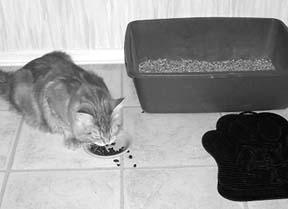
288
Despite the fact that there are so many types of boxes and litter, litterbox avoidance causes more cats to lose their homes than any other unwanted behavior. Therefore, the topic truly matters to cats, and their preferences should matter to us, their caretakers.
Choices Certainly Abound
Before commercial litter, owners provided sand to meet the bathroom needs of cats that lived indoors. It wasnt until 1947 that a product, in the form of absorbent clay, was marketed as cat litter. In 1984, clumping litter was introduced, and it remains more popular than litters made of corn, paper, peanut hull, pine, wheat, silicon, wood fiber and other plant-based materials. Add to that the various products that are scented, unscented, flushable, antibacterial, low-track, no-track and extra-hard clumping for multi-cat households – it should be possible to find a substance that your cat loves to use.
If the variety of litters seems abundant, consider the litterbox options. The varieties include covered, covered with a door flap, filtered, venting, sifting, self-cleaning, rectangles, triangles, ovals, domed, top-opening, rimmed and high- and low-sided.
What Owners and Cats Want
Owners want cost-effective products that control odor, dust and tracking and are easy to use. Cats want a clean, appropriately sized box thats located in an accessible, yet quiet, area where they wont be ambushed by other cats. Its been shown, says Dr. Ilona Rodan, DVM, of the Cat Care Clinic in Madison, Wisconsin, that cats prefer boxes that are at least one-and-a-half times the length of their body, measuring from the nose to the base of the tail. Commercial boxes are too small for many cats and better options are dog litterboxes for dogs up to 35 pounds, plastic sweater storage boxes and cement mixing boxes. Most cats also prefer uncovered boxes and unscented, finer-grained litter.
One Size Doesnt Fit All
Kittens and arthritic cats need low-sided boxes or ones with a low-cut entrance so they can easily enter and exit. Large cats need over-sized boxes and may benefit – along with cats that spray in the box or fling litter – from a high-sided model. The rim sitters, with their ultra-sensitive paws, may need an alternative type of litter.
If you have a multi-cat household and many boxes, you shouldnt place the boxes side-by-side. The cats are likely to regard this as one big box, and it defeats the wisdom of having one box per cat, plus one extra. This is especially important if you live in a multi-story house, where its best to have a litterbox on each level of the home.
If your cat stops using his box, dont assume hes mad at you. Have your cat examined by his veterinarian, and if a medical problem is ruled out, you need to work together to figure out what is causing this lapse. It could be related to the box, especially if youve moved it or introduced a new one, or switched to a type of litter your cat simply doesnt like.
Other stressful disruptions in your cats routine may lead to messages outside the box. Such disruptions might include someone new moving in or someone familiar moving out, the appearance of a strange cat in the yard or a new job that necessitates overtime and less time spent with your cat.
Behavior and medical reasons for litterbox avoidance are often related. For example, if your cat holds his urine because hes waiting for you to clean a dirty box, he may develop lower urinary tract disease. Even when the medical problem is resolved, he may continue to avoid the box because of an association with the previous pain. Likewise, if your cat has experienced difficulty getting in and out of the box because of arthritis, he may also find an alternate bathroom location (the likelihood is that his choice wont be to your liking).
Time for a Change?
The best box and litter wont meet your cats needs if the box is in an inconvenient location or if shes being ambushed by another cat in the home, so try to look at the environment from your cats perspective. And depending on your cats needs related to his age or health status – or the age of a plastic box – it may be time for a change.
Dr. Rodan recommends replacing the box yearly because odor and bacteria can hide in the scratches that cats make. Its important to make any changes gradually. Its a good idea to place some of the used litter in the new box, or mix it with the new litter in your old box to deposit your cats familiar odor. And, by all means, avoid switching boxes and litter at the same time.



